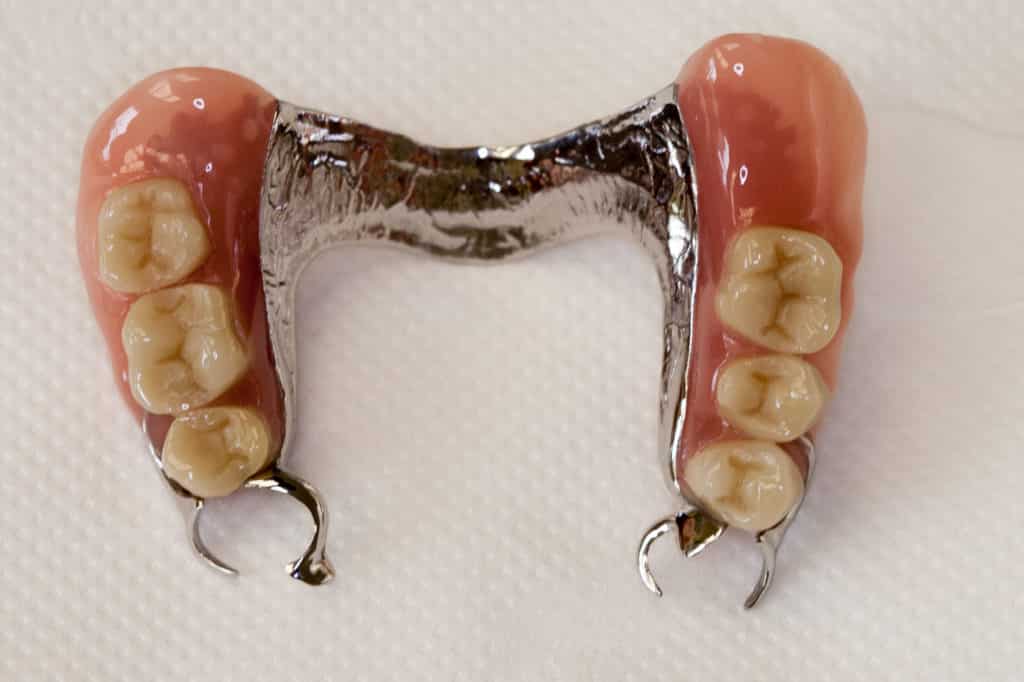What You Need to Know About Partial and Aesthetic Dentures
Let’s make our starting point a clear definition of what dentures are. They are removable or permanent replacements for both missing teeth and some surrounding tissues.
While complete dentures are used for those more rare cases where all a patient’s teeth are missing, we’re going to focus here on the much more frequent use of partial dentures. These work to provide a compatible and aesthetic addition and bridge to those natural teeth which still remain.
Our expert team appreciates that each patient has specific and individual needs. The following information is to paint a general picture and provide answers to some of the most often asked patients’ questions.
An Introduction to Partial Dentures
There are two types of partial dental possibilities: permanent or removable. Here are descriptions of each:
Removable
A removable partial dental bridge is made up of those replacement teeth, placed as required, attached to a natural appearance pink or gum coloured base.
They can also be connected to a flexible metal framework which then holds the denture in place within a patient’s mouth. These additions are used when at least one, usually more, of the natural teeth remain in position in a patient’s upper or lower jaw.
Your precision partial dental can also be removable and often, rather than clasps, uses internal attachments to attach it to the crowns as described below. Many patients find this to be more natural in appearance.
Flexible denture applications are often favoured by patients who have sensitive mouths or suffer from other oral health difficulties.
Permanent
These are also called a fixed bridge, this is achieved by placing crowns on the teeth to either side of where the missing one is to be replaced. The artificial tooth is then attached to them and the fixture is cemented into place.
Our removable or permanent partial and aesthetic dentures are always crafted to the highest of standards to deliver the finest of fits.
A key benefit, and other advantages, of using of partial dentures
As well as filling the spaces left by teeth that have been removed, partial dentures are also important in making sure that the other nearby healthy teeth don’t try to move their position, often called migrating, within the mouth. If they succeed in this shift, this can easily lead to further difficulties.
Other problems that can be caused by this movement can often include awkwardness or discomfort when biting, moderate or even severe pain when moving the jaw, and both headaches and earache. A common early signal of such potential problems can be a popping or clicking sound.
Patients who have undergone the partial denture treatment also regularly report that they find it much easier to chew their food than before.
Appearance wise, these additions can often prevent a sagging appearance of a patient’s cheeks or lips, and also can restore clear speech patterns where it might have become awkward or difficult to pronounce a range of words, phrases or expressions.
Other Important Information to Know About Partial and Aesthetic Dentures
As well as the health benefits these offer, artificial teeth are generally produced using acrylic, sometimes in combination with metal, and can be designed to aesthetically match your other teeth as well as providing an increased level of mouth comfort than that enjoyed before the process was undertaken.
Processes involved in their creation include, either cold or heat cured, pressure, injection and heat-packed. Your specialist will always talk you through the range of options available.
Important Points when Caring for Your Partial Dentures
It’s fairly obvious, if they are removable, that it’s not a good idea to drop them – so they should always be handled with care. Washing and rinsing, using a denture cleaner, helps to destroy harmful bacteria.
Effervescent denture cleaners help remove those awkward and clinging stains and leave a fresh and clean feeling in your mouth. For cleaning your dentures, a small to medium headed brush is an ideal choice.
Should your partial, removable dentures be discoloured and your own efforts cannot return them to their original condition, then your dentist can undertake a professional clean for you. If your partial dentures are cemented permanently in place, then you’ll be cleaning them with as much care and attention as their natural, healthy neighbours.
Are you a Candidate for Partial or Aesthetic Dentures?
Partial dentures have two key purposes. The first is to help you use your mouth as normally as possible, compared to a complete set of natural teeth. The second is to leave a positive aesthetic appearance, allowing you to impress others with a natural and gap-free smile, just as you would hope to with a full set of natural teeth.
Additionally, their use should help maintain the longevity of your other, healthy teeth by providing balanced wear and tear throughout your mouth.
There are a range of situations and circumstances when patients have experienced significant or important tooth loss. Age is not a consideration, partial dentures can be used to help young folk as well as extremely senior citizens and all ages groups in-between. Partial dentures can be placed in either the upper or lower jaw areas.
Taking the First Step Towards Improved Teeth
As we mentioned earlier, every human being is unique – and this applies to each mouth we deal with. Therefore, the starting point is always a detailed personal mouth analysis.
This involves not just inspection, but to discuss how you feel currently and the improvements you personally would like after completing partial or aesthetic denture treatment.
We know that this can be an anxious subject for many individuals, your specialist will always take time to answer every question, deal with any concerns you might have, and take you carefully through the entire process in reassuring detail.
To take that first step, we offer an obligation-free introductory conversation. To take immediate advantage of yours. Fill out the form below.


